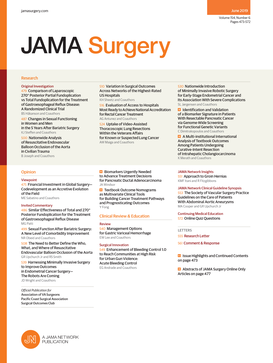Intercostal or Paravertebral Block vs Thoracic Epidural in Lung Surgery: A Randomized Noninferiority Trial.
IF 14.9
1区 医学
Q1 SURGERY
引用次数: 0
Abstract
Importance Effective pain control after thoracic surgery is crucial for enhanced recovery. While thoracic epidural analgesia (TEA) traditionally ensures optimal analgesia, its adverse effects conflict with the principles of enhanced recovery after thoracic surgery. High-quality randomized data regarding less invasive alternative locoregional techniques are lacking. Objective To evaluate the efficacy of continuous paravertebral block (PVB) and a single-shot intercostal nerve block (ICNB) as alternatives to TEA. Design, Setting, and Participants This randomized clinical trial compared PVB and ICNB vs TEA (1:1:1) in patients undergoing thoracoscopic anatomical lung resection at 11 hospitals in the Netherlands and Belgium, enrolled from March 5, 2021, to September 5, 2023. The study used a noninferiority design for pain and a superiority design for quality of recovery (QoR). Interventions Continuous PVB and single-shot ICNB. Main Outcomes and Measures Primary outcomes were pain, defined as mean proportion of pain scores 4 or greater during postoperative days (POD) 0 through 2 (noninferiority margin for the upper limit [UL] 1-sided 98.65% CI, 17.5%), and QoR, assessed with the QoR-15 questionnaire at POD 1 and 2. Secondary measures included opioid consumption, mobilization, complications, and hospitalization. Results A total of 450 patients were randomized, with 389 included in the intention-to-treat (ITT) analysis (mean [SD] age, 66 [9] years; 208 female patients [54%] and 181 male [46%]). Of these 389 patients, 131 received TEA, 134 received PVB, and 124 received ICNB. The mean proportions of pain scores 4 or greater were 20.7% (95% CI, 16.5%-24.9%) for TEA, 35.5% (95% CI, 30.1%-40.8%) for PVB, and 29.5% (95% CI, 24.6%-34.4%) for ICNB. While PVB was inferior to TEA regarding pain (ITT: UL, 22.4%; analysis per-protocol [PP]: UL, 23.1%), ICNB was noninferior to TEA (ITT: UL, 16.1%; PP: UL, 17.0%). The mean (SD) QoR-15 scores were similar across groups: 104.96 (20.47) for TEA, 106.06 (17.94; P = .641) for PVB (P = .64 for that comparison), and 106.85 (21.11) for ICNB (P = .47 for that comparison). Both ICNB and PVB significantly reduced opioid consumption and enhanced mobility compared with TEA, with no significant differences in complications. Hospitalization was shorter in the ICNB group. Conclusions and Relevance After thoracoscopic anatomical lung resection, only ICNB provides noninferior pain relief compared with TEA. ICNB emerges as an alternative to TEA, although risks and benefits should be weighed for optimal personalized pain control. Trial Registration ClinicalTrials.gov Identifier: NCT05491239.肺手术中肋间或椎旁阻滞vs胸硬膜外阻滞:一项随机非劣效性试验。
重要性胸外科手术后有效的疼痛控制对增强康复至关重要。虽然传统的胸椎硬膜外镇痛(TEA)可以保证最佳的镇痛效果,但其副作用与提高胸外科手术后恢复的原则相冲突。缺乏关于侵入性较小的局部替代技术的高质量随机数据。目的评价连续椎旁神经阻滞(PVB)和单次肋间神经阻滞(ICNB)替代TEA的疗效。设计、环境和参与者本随机临床试验比较了PVB和ICNB与TEA(1:1:1)在荷兰和比利时的11家医院接受胸腔镜解剖肺切除术的患者中(从2021年3月5日到2023年9月5日)。本研究采用疼痛的非劣效设计和恢复质量(QoR)的优效设计。干预措施:连续PVB和单次ICNB。主要结局和测量方法主要结局是疼痛,定义为术后天数(POD) 0至2的疼痛评分4分或以上的平均比例(上限非劣效性裕度[UL]单侧98.65% CI, 17.5%)和QoR,在POD 1和2时用QoR-15问卷评估。次要措施包括阿片类药物消耗、活动、并发症和住院。结果共纳入450例患者,其中389例纳入意向治疗(ITT)分析(平均[SD]年龄66岁;女性208例(54%),男性181例(46%))。389例患者中,131例接受TEA, 134例接受PVB, 124例接受ICNB。疼痛评分4分及以上的平均比例为:TEA为20.7% (95% CI, 16.5%-24.9%), PVB为35.5% (95% CI, 30.1%-40.8%), ICNB为29.5% (95% CI, 24.6%-34.4%)。而PVB在疼痛方面不如TEA (ITT: UL, 22.4%;协议分析[PP]: UL, 23.1%), ICNB不逊于TEA (ITT: UL, 16.1%;Pp: 17.0%)。各组间QoR-15的平均(SD)评分相似:TEA为104.96 (20.47),106.06 (17.94);P = .641)。而ICNB为106.85 (21.11)(P =。47分)。与TEA相比,ICNB和PVB均能显著减少阿片类药物的消耗,增强活动能力,并发症无显著差异。ICNB组住院时间较短。结论及相关性胸腔镜解剖肺切除术后,与TEA相比,只有ICNB能提供非亚下性疼痛缓解。ICNB作为TEA的替代品出现,尽管风险和收益应该权衡最佳的个性化疼痛控制。临床试验注册号:NCT05491239。
本文章由计算机程序翻译,如有差异,请以英文原文为准。
求助全文
约1分钟内获得全文
求助全文
来源期刊

JAMA surgery
SURGERY-
CiteScore
20.80
自引率
3.60%
发文量
400
期刊介绍:
JAMA Surgery, an international peer-reviewed journal established in 1920, is the official publication of the Association of VA Surgeons, the Pacific Coast Surgical Association, and the Surgical Outcomes Club.It is a proud member of the JAMA Network, a consortium of peer-reviewed general medical and specialty publications.
 求助内容:
求助内容: 应助结果提醒方式:
应助结果提醒方式:


